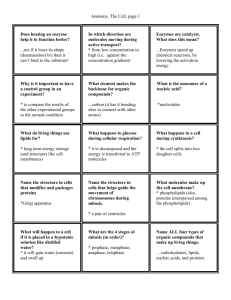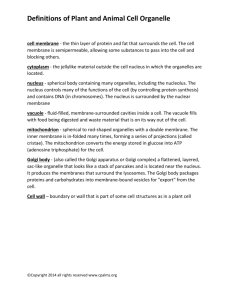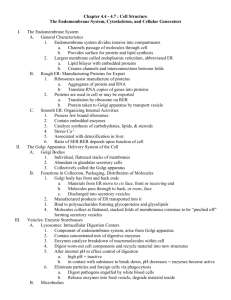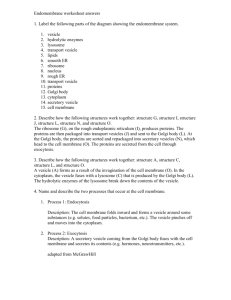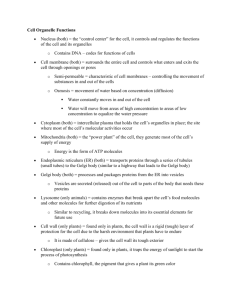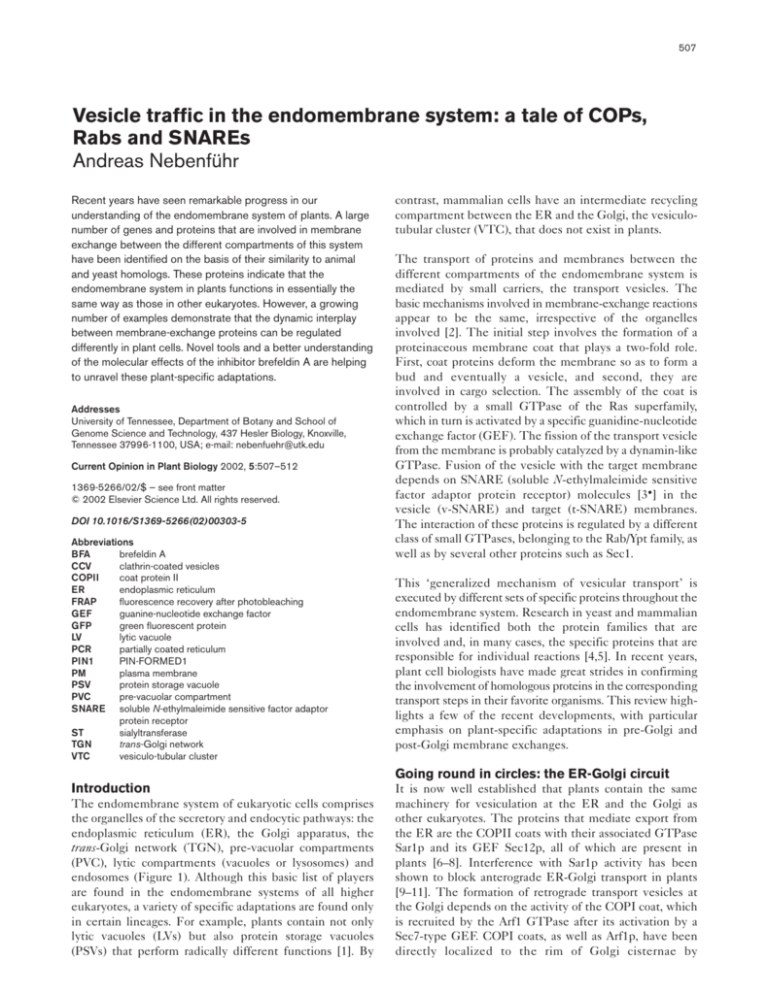
507
Vesicle traffic in the endomembrane system: a tale of COPs,
Rabs and SNAREs
Andreas Nebenführ
Recent years have seen remarkable progress in our
understanding of the endomembrane system of plants. A large
number of genes and proteins that are involved in membrane
exchange between the different compartments of this system
have been identified on the basis of their similarity to animal
and yeast homologs. These proteins indicate that the
endomembrane system in plants functions in essentially the
same way as those in other eukaryotes. However, a growing
number of examples demonstrate that the dynamic interplay
between membrane-exchange proteins can be regulated
differently in plant cells. Novel tools and a better understanding
of the molecular effects of the inhibitor brefeldin A are helping
to unravel these plant-specific adaptations.
Addresses
University of Tennessee, Department of Botany and School of
Genome Science and Technology, 437 Hesler Biology, Knoxville,
Tennessee 37996-1100, USA; e-mail: nebenfuehr@utk.edu
Current Opinion in Plant Biology 2002, 5:507–512
1369-5266/02/$ — see front matter
© 2002 Elsevier Science Ltd. All rights reserved.
DOI 10.1016/S1369-5266(02)00303-5
Abbreviations
BFA
brefeldin A
CCV
clathrin-coated vesicles
COPII
coat protein II
ER
endoplasmic reticulum
FRAP
fluorescence recovery after photobleaching
GEF
guanine-nucleotide exchange factor
GFP
green fluorescent protein
LV
lytic vacuole
PCR
partially coated reticulum
PIN1
PIN-FORMED1
PM
plasma membrane
PSV
protein storage vacuole
PVC
pre-vacuolar compartment
SNARE soluble N-ethylmaleimide sensitive factor adaptor
protein receptor
ST
sialyltransferase
TGN
trans-Golgi network
VTC
vesiculo-tubular cluster
contrast, mammalian cells have an intermediate recycling
compartment between the ER and the Golgi, the vesiculotubular cluster (VTC), that does not exist in plants.
The transport of proteins and membranes between the
different compartments of the endomembrane system is
mediated by small carriers, the transport vesicles. The
basic mechanisms involved in membrane-exchange reactions
appear to be the same, irrespective of the organelles
involved [2]. The initial step involves the formation of a
proteinaceous membrane coat that plays a two-fold role.
First, coat proteins deform the membrane so as to form a
bud and eventually a vesicle, and second, they are
involved in cargo selection. The assembly of the coat is
controlled by a small GTPase of the Ras superfamily,
which in turn is activated by a specific guanidine-nucleotide
exchange factor (GEF). The fission of the transport vesicle
from the membrane is probably catalyzed by a dynamin-like
GTPase. Fusion of the vesicle with the target membrane
depends on SNARE (soluble N-ethylmaleimide sensitive
factor adaptor protein receptor) molecules [3•] in the
vesicle (v-SNARE) and target (t-SNARE) membranes.
The interaction of these proteins is regulated by a different
class of small GTPases, belonging to the Rab/Ypt family, as
well as by several other proteins such as Sec1.
This ‘generalized mechanism of vesicular transport’ is
executed by different sets of specific proteins throughout the
endomembrane system. Research in yeast and mammalian
cells has identified both the protein families that are
involved and, in many cases, the specific proteins that are
responsible for individual reactions [4,5]. In recent years,
plant cell biologists have made great strides in confirming
the involvement of homologous proteins in the corresponding
transport steps in their favorite organisms. This review highlights a few of the recent developments, with particular
emphasis on plant-specific adaptations in pre-Golgi and
post-Golgi membrane exchanges.
Going round in circles: the ER-Golgi circuit
Introduction
The endomembrane system of eukaryotic cells comprises
the organelles of the secretory and endocytic pathways: the
endoplasmic reticulum (ER), the Golgi apparatus, the
trans-Golgi network (TGN), pre-vacuolar compartments
(PVC), lytic compartments (vacuoles or lysosomes) and
endosomes (Figure 1). Although this basic list of players
are found in the endomembrane systems of all higher
eukaryotes, a variety of specific adaptations are found only
in certain lineages. For example, plants contain not only
lytic vacuoles (LVs) but also protein storage vacuoles
(PSVs) that perform radically different functions [1]. By
It is now well established that plants contain the same
machinery for vesiculation at the ER and the Golgi as
other eukaryotes. The proteins that mediate export from
the ER are the COPII coats with their associated GTPase
Sar1p and its GEF Sec12p, all of which are present in
plants [6–8]. Interference with Sar1p activity has been
shown to block anterograde ER-Golgi transport in plants
[9–11]. The formation of retrograde transport vesicles at
the Golgi depends on the activity of the COPI coat, which
is recruited by the Arf1 GTPase after its activation by a
Sec7-type GEF. COPI coats, as well as Arf1p, have been
directly localized to the rim of Golgi cisternae by
508
Cell biology
Figure 1
ER
COPII
COPI
PAC
Golgi
COPI
TGN
DV
CCV
PSV
PVC
?
LV
CCV?
The major organelles of the endomembrane
system and the membrane exchange routes
that connect them. Proteins are synthesized in
the ER and travel through the Golgi to the
TGN. There, they are sorted for transport to
the PM, PVC or the PSV. The PVC is the
antechamber of the LV and serves as a
recycling compartment for sorting receptors.
The PCR presumably corresponds to the
endosomes of mammalian cells. The
membrane coats that are involved in vesicle
formation are indicated next to the arrows
where known. Dense vesicles (DV) are not
formed by coats but by aggregation of cargo
molecules. An alternative route into the PSV
for certain storage proteins leads directly from
the ER via precursor accumulating vesicles
(PAC). The relationship between the
PCR/endosome and the other post-Golgi
organelles is largely unknown. Anterograde
transport through the Golgi and into the TGN
does not involve vesicles but is mediated by
cisternal maturation.
PCR
?
PM
Current Opinion in Plant Biology
immunocytochemistry with both light and electron
microscopy [12,13••]. Interestingly, Arf1-like epitopes are
also present at the plasma membrane of maize root cells
[14]. Furthermore, the recruitment of COPI coats to Golgi
membranes from cauliflower and tobacco could be reconstituted in vitro [12], an important prerequisite for detailed
biochemical studies of vesicle formation and cargo selection.
The components that are involved in vesicle fusion at the
ER and Golgi in mammals and yeast also appear to operate
in similar fashion in plants. Although the SNARE proteins
in this part of the endomembrane system have not been
characterized in detail, the involvement of AtRab1b and
NtRab2 proteins in ER-Golgi transport has been shown
using dominant negative mutants [15,16]. It is currently
not clear which transport step(s) are regulated by these
Rab proteins. NtRab1b-GFP (for green fluorescent protein)
fusion proteins are localized to the ER and the Golgi in leaf
epidermal cells, whereas Rab2-GFP fusions are found on the
Golgi in pollen tubes [16]. NtRab2 expression is limited to
rapidly growing tissues, suggesting that it plays an accessory
role in cells that have very active secretory systems [16].
From these studies, it is clear that the basic machinery for
the production of vesicles at the ER-Golgi interface is the
same in plants as in other eukaryotes. This is also illustrated
by the early responses to the fungal toxin brefeldin A
(BFA). BFA inhibits the activation of Arf1 by a subset of
Sec7-type GEFs [17], and thereby blocks the formation of
COPI coats and retrograde traffic within the Golgi and
back to the ER. Recently, Ritzenthaler et al. [13••] showed
that this is also the case in tobacco Bright Yellow-2 (BY-2)
cells, thus reinforcing the basic similarity between all
eukaryotes. Interestingly, this identical primary BFA effect
is followed in plants by secondary and tertiary consequences
that only partially mimic the responses in mammalian
cells. The mammalian Golgi quickly loses its structural
integrity in response to BFA [18], forming elongated
tubules that stretch along microtubules into the cell
periphery [19]. By contrast, plant Golgi stacks initially
maintain their structural identity after treatment with BFA,
except for an apparent loss of cis cisternae [13••].
Eventually, Golgi membranes fuse with the ER in both
mammalian and plant cells, resulting in the formation of an
ER–Golgi hybrid compartment, but again, the morphological
manifestation in plants is unique. In plant cells, the merger
is more gradual than that in the cells of other eukaryotes, it
does not depend on cytoskeletal elements [20] and, at least
in cells with prominent intercisternal elements, it proceeds
via unusual ER-Golgi hybrid stacks (Figure 2; [13••]).
These stacks form by the fusion of individual Golgi cisternae
with the ER, the intercisternal elements seem to prevent
the new hybrid cisterna from drifting away. Thus, the ERGolgi hybrid stacks are probably a reflection of the high
structural stability of plant Golgi stacks, which is necessitated
by their rapid stop-and-go movements [21]. It will be
Vesicle traffic in the endomembrane system Nebenführ
interesting to see whether this enhanced structural stability
in plants is the result of novel proteins or whether it is
simply brought about by the greater expression of common
Golgi-matrix proteins.
Despite the high level of structural integrity of plant Golgi
stacks, it is clear that there is a constant anterograde flux
of secretory products through their cisternae that has to
be counterbalanced by a similar retrograde flux of Golgiresident enzymes [22,23]. This recycling of Golgi proteins
can reach as far back as the ER, and has been demonstrated
in elegant experiments using fluorescence recovery after
photobleaching (FRAP) [24•]. To observe FRAP, a small
region of a cell is selectively bleached with high laser
power. The loss of fluorescence of the reporter molecules
in the affected area is irreversible, so any recovery of
fluorescence has to be the result of new molecules entering
the region. In the case of the Golgi, the most likely source
of such molecules is the ER. Using this approach,
Brandizzi et al. [24•] discovered that the Golgi-localized
fluorescence of Arabidopsis thaliana ER-RETENTION
DEFECTIVE2 (AtERD2)-GFP and rat sialyltransferase
(ST)-GFP fusions can recover pre-bleach values within
just five minutes. On the basis of data from mammalian
cells, we can assume that this influx of new Golgi proteins
is balanced by a recycling of old, bleached proteins back to
the ER. These FRAP experiments therefore demonstrate
a basic similarity between the Golgi of plants and mammals,
namely that Golgi proteins cycle between their predominant
localization in the Golgi and a temporary presence in the ER.
At the same time, however, these studies demonstrate a
difference between the endomembrane systems of the two
groups. In plants, unlike in mammals, the FRAP effect
was observed in both the presence and the absence of
microtubules [24•]. In fact, no cytoskeletal elements are
needed for the replacement of Golgi proteins in plants as
all of the experiments were conducted in the presence of
latrunculin B to prevent rapid Golgi movements [24•]. It is
possible that the rate of fluorescence recovery would be
different in the presence of actin filaments, but active
Golgi movement is not strictly required for ER-Golgi
transport. This conclusion plays directly into the current
debate on how efficient ER-Golgi transport is possible in
a system with such a high degree of mobility [21].
Interestingly, the new data suggest yet another interpretation, namely that Golgi stacks and ER export sites
travel together through the cytoplasm as functional units,
and therefore are closely apposed when actin-based
movements are disrupted [24•]. Clearly, the answer to the
question of how vesicles that are exported from the ER
reach the Golgi hasn’t yet been found. It probably has
to await a better characterization of the sites of vesicle
formation at the ER.
The FRAP experiments have also resulted in two curious,
unexpected observations. The first was that two markers
with different, albeit overlapping, distribution in Golgi
509
Figure 2
Current Opinion in Plant Biology
ER-Golgi stacks in a BFA-treated Bright Yellow-2 (BY-2) cell.
stacks had identical FRAP rates [24•]. The AtERD2-GFP
marker would have been predicted to recycle more quickly
than ST-GFP because of its localization in the cis Golgi and
its role in returning escaped ER residents. It remains to be
seen whether this apparently indiscriminate recycling rate
also holds true for endogenous proteins, or whether it
results from the use of heterologous markers. The second
unexpected observation was that BFA prevented ER-Golgi
transport in about half of the Golgi stacks tested [24•]. The
known BFA target resides on the Golgi and is involved in
retrograde transport (see above), so any effect on anterograde
transport is likely an indirect one. It has been proposed
that this indirect effect acts by blocking COPII-mediated
vesicle formation at the ER [24•]. Alternatively, it is
conceivable that the inhibition occurs at the level of the
Golgi, where BFA treatment may prevent the integration
of transport vesicles into the maturing cisternae [25]. The
FRAP experiments, by nature of their design, cannot
distinguish between these possibilities and we will have to
find other ways of addressing this problem, as well as the
question of why only half of the stacks were affected by BFA.
Grand central: the TGN-PVC-PCR sorting station
The situation on the far end of the Golgi is more complex
than that on its cis side as it involves a branching of the
anterograde pathway to the plasma membrane (PM) and
the vacuoles, as well as the integration of the endocytic
pathway. This complexity is illustrated by the plethora of
syntaxin-like SNARE proteins that are found on the TGN
510
Cell biology
Figure 3
Golgi
BFA
TGN
BFA
compartment
BFA
ST-myc
GONST1
BFA
JIM84 epitopes
PIN1
PIN3
AUX1
H+-ATPase
Pectin
LV
FM1-43
BFA
are thought to be remnants of the disintegrated Golgi
apparatus [30]. Interestingly, recent work with plasma
membrane proteins suggests that endocytic vesicles may
accumulate in the same structures. Treatment of
Arabidopsis seedlings with BFA leads to a mislocalization of
the putative auxin-efflux carrier PIN-FORMED1 (PIN1)
in root cells: the PIN1 signal at the PM is reduced and
large perinuclear aggregates appear instead [31••]. Similar
results were obtained with the related protein PIN3 [32•],
+
the PM H -ATPase [14,31••], and the putative auxin-influx
carrier AUXIN-INSENSITIVE1 (AUX1) [33•]. Curiously,
meristematic cells in the root tip of maize also accumulated
a cell-wall-modified pectin in similar perinuclear aggregates
[14]. The size, distribution, and dependence on drug
treatment of these aggregates suggest that these are socalled BFA compartments. The new data on PM proteins
thus suggest that the endocytic pathway also feeds into
BFA compartments, although it has to be cautioned that
double labeling with a bona fide BFA compartment marker,
such as JIM84, has not been carried out so far.
PM
Current Opinion in Plant Biology
Hypothetical sites of BFA action in post-Golgi compartments. Many
molecules that originate in either the (TGN) or the PM seem to
accumulate in the same perinuclear aggregate, the BFA compartment
(gray area). This accumulation suggests that export from the BFA
compartment towards the PM, the TGN and the LV is sensitive to BFA.
Input into the BFA compartment from the Golgi is prevented by the
fusion of Golgi cisternae with the ER. AUX1, AUXIN INSENSITIVE 1;
GONST1, GOLGI NUCLEOTIDE SUGAR TRANSPORTER1 [37];
ST-myc, rat sialyltransferase with myc epitope tag [38].
and the PVC. Four different syntaxin proteins (SYP41,
SYP42, SYP51, and SYP61) have been localized to the TGN
of Arabidopsis root cells by immuno-electronmicroscopy,
and four (SYP21, SYP22, SYP51, and SYP61) have been
detected on the PVC [26,27•,28•]. It is not likely that the
high density of syntaxins on these organelles reflects
redundancy as knockouts of either of the SYP4x or SYP2x
genes are gametophytic lethals [29]. In addition, these
syntaxins interact only with certain other members of the
SNARE family, as demonstrated by pull-down assays
[27•,28•]. The related syntaxins SYP41 and SYP42 are
sorted into different sub-domains of the TGN [27•]. All of
these findings demonstrate a high degree of differentiation
of the post-Golgi compartments, and the large number of
specific membrane-recognition events that are possible.
Another indication that the post-Golgi and endocytic
compartments are interconnected by a complex set of
membrane-exchange reactions is provided by the effects of
BFA on secreted and endocytosed proteins. Early work
with this drug has established that glycoproteins that are
secreted from the Golgi, as detected by the JIM84 antibody,
accumulate in large perinuclear clusters in BFA-treated
plant cells [30]. These highly vesiculated membrane
aggregations have been termed BFA compartments, and
At face value, this conclusion seems to indicate that
recycled PM proteins and secretory cargo (JIM84) travel to
the cell surface in the same carrier, or at least via similar
mechanisms that both can be inhibited by BFA. However,
our knowledge of how BFA achieves this effect is so far
only conjecture (Figure 3). Export from the TGN in
clathrin-coated vesicles (CCV), which is BFA-sensitive in
animal cells, has only been shown for vacuolar proteins. It
is not clear how BFA treatment could affect transport to
the PM in plants as no membrane coat is known to be
involved in this step. Furthermore, a recent study that
demonstrated the importance of the dynamin-related
protein AtADL6 in transport from the TGN to the PVC
also illustrated that a block of the vacuolar branch does not
interfere with traffic to the PM [34]. Similar uncertainty
exists in the endocytotic pathway. Delivery of the FM1-43
tracer of endocytosis to the central vacuole is sensitive to
BFA [35], but it is not clear at which stage of the transport
the BFA block occurs. One candidate organelle for this block
is the partially coated reticulum (PCR), which is thought to
represent endosomes in plants [36]. Thus, the relationship
between the endocytic, secretory and vacuolar pathways in
plants is still unclear. If the large number of syntaxins at
the TGN and the PVC are any indication, we can expect
that many membrane exchange reactions await discovery.
Conclusions
Although the bulk of the recent developments confirms the
paradigm of membrane exchange that has been developed
in mammalian and yeast cells, there is also a growing
awareness of unique adaptations in plants. This reflects a
trend away from ‘inventory’ studies, which catalogue
proteins that are involved in membrane transport, towards
functional studies that aim to elucidate the roles of individual
proteins in the mechanisms of membrane exchange. This
trend will likely accelerate in the future as more proteins
are known and novel markers for the different compartments
Vesicle traffic in the endomembrane system Nebenführ
are developed. The availability of the full genomic
sequence of Arabidopsis, and soon rice, as well a range
of molecular tools to interfere with individual genes and
proteins will support this process significantly. We can
expect to see rapid progress in our understanding of the
endocytic pathway and its integration with secretion. The
‘GFP revolution’ will continue to provide important new
insights to the dynamic interplay of the different transport
steps as new experimental approaches are developed. It
is hoped that the number of question marks in the next
version of Figure 1 will be greatly decreased.
14. Baluska F, Hlavacka A, Samaj J, Palme K, Robinson DG, Matoh T,
McCurdy DW, Menzel D, Volkmann D: F-actin-dependent
endocytosis of cell wall pectins in meristematic root cells:
insights from brefeldin A-induced compartments. Plant Physiol
2002, 130:422-431.
15. Batoko H, Zheng H-Q, Hawes C, Moore I: A Rab1 GTPase is
required for transport between the endoplasmic reticulum and
Golgi apparatus and for normal Golgi movement in plants. Plant
Cell 2000, 12:2201-2218.
16. Cheung AY, Chen CY-h, Glaven RH, de Graaf BHJ, Vidali L, Heplaer PK,
Wu H-m: Rab2 GTPase regulates vesicle trafficking between the
endoplasmic reticulum and the Golgi bodies and is important for
pollen tube growth. Plant Cell 2002, 14:945-962.
17.
Acknowledgement
I would like to thank Andrew Staehelin for helpful comments on the
manuscript.
References and recommended reading
Papers of particular interest, published within the annual period of review,
have been highlighted as:
• of special interest
•• of outstanding interest
1.
Vitale A, Raikhel NV: What do proteins need to reach different
vacuoles? Trends Plant Sci 1999, 4:149-155.
2.
Robinson DG, Hinz G, Holstein SEH: The molecular characterization
of transport vesicles. Plant Mol Biol 1998, 38:47-76.
511
Jackson CL, Casanova JE: Turning on ARF: the Sec7 family of
guanine-nucleotide exchange factors. Trends Cell Biol 2000,
10:60-67.
18. Hess MW, Müller M, Debbage PL, Vetterlein M, Pavelka M:
Cryopreparation provides new insight into the effect of brefeldin A
on the structure of the HepG2 Golgi apparatus. J Struct Biol 2000,
130:63-72.
19. Sciaky N, Presley J, Smith C, Zaal KJM, Cole N, Moreira JE, Terasaki M,
Siggia E, Lippincott-Schwartz J: Golgi tubule traffic and the effects
of brefeldin A visualized in living cells. J Cell Biol 1997,
139:1137-1155.
20. Saint-Jore CM, Evins J, Batoko H, Brandizzi F, Moore I, Hawes C:
Redistribution of membrane proteins between the Golgi
apparatus and endoplasmic reticulum in plants is reversible and
not dependent on cytoskeletal networks. Plant J 2002,
29:661-678.
Sanderfoot AA, Assaad FF, Raikhel NV: The Arabidopsis genome.
An abundance of soluble N-ethylmaleimide-sensitive factor
adaptor protein receptors. Plant Physiol 2000, 124:1558-1569.
The authors present not only an exhaustive search of the Arabidopsis genome
for SNARE proteins but also a good primer on membrane fusion events. In
addition, they revise the nomenclature of plant syntaxins, which should help
to reduce the confusion caused by borrowing names from yeast or mammals.
21. Nebenführ A, Staehelin LA: Mobile factories: Golgi dynamics in
plant cells. Trends Plant Sci 2001, 6:160-167.
4.
Béraud-Dufour S, Balch W: Cell science at a glance: a journey
through the exocytic pathway. J Cell Sci 2002, 115:1779-1780.
5.
Sorkin A: Cell science at a glance: the endocytosis machinery.
J Cell Sci 2000, 113:4375-4376.
6.
Bar-Peled M, Raikhel NV: Characterization of AtSEC12 and
AtSAR1. Proteins likely involved in endoplasmic reticulum and
Golgi transport. Plant Physiol 1997, 114:315-324.
7.
Andreeva AV, Kutuzov MA, Evans DE, Hawes CR: Proteins involved
in membrane transport between the ER and the Golgi apparatus:
21 putative plant homologues revealed by dbEST searching. Cell
Biol Int 1998, 22:145-160.
24. Brandizzi F, Snapp E, Roberts A, Lippincott-Schwartz J, Hawes C:
•
Membrane protein transport between the ER and Golgi in tobacco
leaves is energy dependent but cytoskeleton independent:
evidence from selective photobleaching. Plant Cell 2002,
14:1293-1309.
This is the first study to use FRAP to elucidate membrane dynamics in the
plant endomembrane system. It demonstrates the continuous cycling of
Golgi residents between the Golgi and the ER. The authors also discover
that this recycling in plant cells, in contrast to that in animal cells, is not
dependent on cytoskeletal elements.
3.
•
8.
Movafeghi A, Happel N, Pimpl P, Tai G-H, Robinson DG: Arabidopsis
Sec21p and Sec23p homologs. Probable coat proteins of plant
COP-coated vesicles. Plant Physiol 1999, 119:1437-1445.
9.
Andreeva AV, Zheng H, Saint-Jore CM, Kutuzov MA, Evans DE,
Hawes CR: Organization of transport from endoplasmic reticulum
to Golgi in higher plants. Biochem Soc Trans 2000, 28:505-512.
10. Takeuchi M, Ueda T, Sato K, Abe H, Nagata T, Nakano A: A dominant
negative mutant of Sar1 GTPase inhibits protein transport from
the endoplasmic reticulum to the Golgi apparatus in tobacco and
Arabidopsis cultured cells. Plant J 2000, 23:517-525.
11. Phillipson BA, Pimpl P, Pinto daSilva LL, Crofts AJ, Taylor JP, Movafeghi A,
Robinson DG, Denecke J: Secretory bulk flow of soluble proteins is
efficient and COPII dependent. Plant Cell 2001, 13:2005-2020.
12. Pimpl P, Movafeghi A, Coughlan S, Denecke J, Hillmer S, Robinson DG:
In situ localization and in vitro induction of plant COPI-coated
vesicles. Plant Cell 2000, 12:2219-2236.
13. Ritzenthaler C, Nebenführ A, Movafeghi A, Stussi-Garaud C, Behnia L,
•• Pimpl P, Staehelin LA, Robinson DG: Reevaluation of the effects of
brefeldin A on plant cells using tobacco bright yellow 2 cells
expressing Golgi-targeted green fluorescent protein and COPI
antisera. Plant Cell 2002, 14:237-261.
A combination of approaches is used to characterize BFA responses in
detail. These confirm that the primary response to BFA in plants is a loss of
COPI from the Golgi. The subsequent fusion of the Golgi with the ER occurs
via unusual ER–Golgi hybrid stacks that are unique to plants.
22. Pelham HRB: Traffic through the Golgi apparatus. J Cell Biol 2001,
155:1099-1101.
23. Nebenführ A: Intra-Golgi transport: escalator or bucket brigade?
Annu Plant Rev 2002, in press.
25. Nebenführ A, Ritzenthaler C, Robinson DG: Update on Brefeldin A:
deciphering an enigmatic inhibitor of secretion. Plant Physiol
2002, 130:in press.
26. Sanderfoot AA, Kovaleva V, Zheng H, Raikhel NV: The t-SNARE
AtVAM3p resides on the prevacuolar compartment in Arabidopsis
root cells. Plant Physiol 1999, 121:929-938.
27.
•
Bassham DC, Sanderfoot AA, Kovaleva V, Zheng H, Raikhel NV:
AtVPS45 complex formation at the trans-Golgi network. Mol Biol
Cell 2000, 11:2251-2265.
This study combines thorough biochemical and cell-biological approaches to
characterize SNAREs and related proteins at the TGN and PVC.
Immunogold double-labeling studies and pull-down assays demonstrate
the distribution of the proteins on the compartments and, at the same time,
suggest possible ways in which they can interact to carry out their functions.
28. Sanderfoot AA, Kovaleva V, Bassham DC, Raikhel NV: Interactions
•
between syntaxins identify at least five SNARE complexes within
the Golgi/prevacuolar system of the Arabidopsis cell. Mol Biol
Cell 2001, 12:3733-3743.
Similarly to [27•], this study reveals a variety of interactions of SNARE
molecules at the TGN and PVC, and highlights the large number of different
interactions that are possible.
29. Sanderfoot AA, Pilgrim M, Adam L, Raikhel NV: Disruption of
individual members of Arabidopsis syntaxin gene families
indicates each has essential function. Plant Cell 2001,
13:659-666.
30. Satiat-Jeunemaitre B, Cole L, Bouret T, Howard R, Hawes C:
Brefeldin A effects in plant and fungal cells: something new about
vesicle trafficking? J Microsc 1996, 181:162-177.
512
Cell biology
31. Geldner N, Friml J, Stierhof Y-D, Jürgens G, Palme K: Auxin transport
•• inhibitors block PIN1 cycling and vesicle trafficking. Nature 2001,
413:425-428.
See annotation for [33•].
34. Jin JB, Kim YA, Kim SJ, Lee SH, Kim DH, Cheong G-W, Hwang I:
A new dynamin-like protein, ADL6, is involved in trafficking from
the trans-Golgi network to the central vacuole in Arabidopsis.
Plant Cell 2001, 13:1511-1525.
32. Friml J, Wisniewska J, Benkova E, Mengden K, Palme K: Lateral
•
relocation of auxin efflux regulator PIN3 mediates tropism in
Arabidopsis. Nature 2002, 415:806-809.
See annotation for [33•].
35. Emans N, Zimmermann S, Fischer R: Uptake of a fluorescent
marker in plant cells is sensitive to brefeldin A and wortmannin.
Plant Cell 2002, 14:71-86.
33. Grebe M, Friml J, Swarup R, Ljung K, Sandberg G, Terlou M, Palme K,
•
Bennett MJ, Scheres B: Cell polarity signaling in Arabidopsis
involves a BFA-sensitive auxin influx pathway. Curr Biol 2002,
12:329-334.
The authors of these three papers [31••,32•,33•] demonstrate that the
polarized distribution of PM proteins in plants is probably maintained by
continuous endocytosis and re-targeting to the cell surface. This dynamic
view is a dramatic departure from the old conjecture that endocytosis is
impossible in cells that have high turgor pressure.
36. Staehelin LA, Moore I: The plant Golgi apparatus: structure,
functional organization and trafficking mechanisms. Annu Rev
Plant Physiol Plant Mol Biol 1995, 46:261-288.
37.
Baldwin TC, Handford MG, Yuseff M-I, Orellana A, Dupree P:
Identification and characterization of GONST1, a Golgi-localized GDPmannose transporter in Arabidopsis. Plant Cell 2001, 13:2283-2295.
38. Wee EG-T, Sherrier DJ, Prime TA, Dupree P: Targeting of active
sialyltransferase to the plant Golgi apparatus. Plant Cell 1998,
10:1759-1768.





